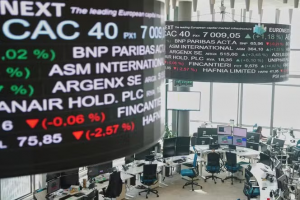U.S. stock futures climb on Monday, with reports suggesting that a key upcoming tariff announcement from President Donald Trump will be less severe than initially expected. According to Bloomberg News, Trump is planning to unveil more targeted measures next week. Elsewhere, Canadian Prime Minister Mark Carney calls for a snap election next month as the country faces threats of tariffs from Trump.
1. Futures higher
U.S. stock futures ticked higher as investors gauged reports on an upcoming deadline for President Trump’s reciprocal tariffs and looked ahead to key economic data this week.
By 04:49 ET (08:49 GMT), the Dow futures contract had gained 330 points or 0.8%, S&P 500 futures had inched up by 58 points or 1.0%, and Nasdaq 100 futures had advanced by 245 points or 1.2%.
The main averages ended the prior week in the green, while the dollar climbed, after Trump said there could be some flexibility in his tariff stance, raising hopes that sweeping levies due to come into effect on April 2 may not be as harsh as initially thought. All three of the indices -- the benchmark S&P 500, the tech-heavy Nasdaq Composite, and blue-chip Dow Jones Industrial Average -- notched weekly gains.
Still, worries surrounded the potential consequences of the changes on both business activity and the broader economic outlook. Semiconductors, materials, and small cap stocks -- all considered to be exposed to a possible slowing in the economy -- limited Friday’s increases in equities. 2. Trump’s April 2 tariffs announcement could be more targeted - Bloomberg News
Bolstering sentiment on Monday was a weekend report from Bloomberg News that Trump could unveil tariffs at an April 2 "Liberation Day" announcement that are more targeted than he has previously threatened.
Trump has said in prior weeks that he would roll out sprawling tariffs on both friends and foes alike in response to perceived trade imbalances. But Trump’s announcement -- while still a significant expansion of his aggressive approach to international trade -- may exclude some nations or blocs, the Bloomberg report said, citing aides and allies to the president.
Tariffs on specific sectors, another possible measure floated by Trump, will also likely not be revealed at the event.
However, Trump is planning to announce tariff rates that are due to come into effect immediately, likely provoking retaliatory countermeasures from some countries, the report said. Those countries who do not impose tariffs on the U.S. and with whom the U.S. has a trade surplus may be exempted from the reciprocal levies, Bloomberg added.
"Targeted is obviously better than the alternative, but the trade changes being envisioned are still substantial, and it’s likely they will have negative effects on the economy and corporate profits, at least in the near and medium term," analysts at Vital Knowledge said in a note to clients.
3. Canadian snap election called
Canadian Prime Minister Mark Carney has called a snap election for April 28, arguing that the country’s leader needs a strong mandate to take on threats from Trump.
Tensions between Canada and its neighbor to the south have risen since Trump’s return to the White House earlier this year. Trump has delayed a broad 25% tariff on Canada, imposed separate levies on steel and aluminum, and threatened reciprocal duties on items like dairy and lumber -- all while suggesting that the U.S. could eventual annex the country as its "51st state."
The actions and comments have stoked retaliatory trade measures from Ottawa and demands that Washington treat its traditional ally with respect. Economists have warned, however, that heavy tariffs could damage a Canadian economy that is heavily reliant on exports to the U.S.
Carney became Prime Minister on March 14 after winning a Liberal Party vote to replace former leader Justin Trudeau. Carney, a former central banker, has said he would strive to work with Trump, but on Sunday called Trump’s tariffs and rhetoric the "most significant crisis of our lifetimes."
4. PMIs ahead
On the economic calendar, markets will be keeping an eye on the latest measure of U.S. business activity after the figure almost stalled in the prior month.
The preliminary S&P Global Composite purchasing managers’ index, a tracker of the manufacturing and services sectors, is seen edging down to 51.5 in March. A reading above 50 denotes expansion.
In February, the measure came in at 51.6. The flash gauge initially came in at 50.4, marking a 17-month low and adding to a series of data points that were suggesting that businesses and consumers were becoming increasingly concerned about the impact of Trump’s tariff plans.
Meanwhile, investors are awaiting the release later in the week of the personal consumption expenditures price index, an inflation metric closely followed by Federal Reserve policymakers.
Last week, the central bank left interest rates unchanged and presented an outlook for the economy that included higher inflation and cooling economic growth. Still, Fed Chair Jerome Powell described the U.S. economy as "strong overall" despite some moderation in consumer spending.













